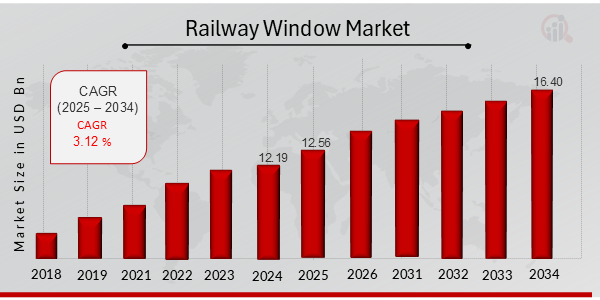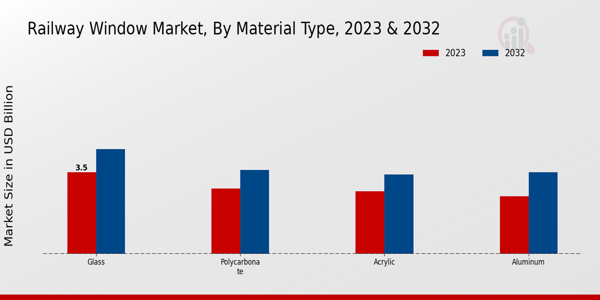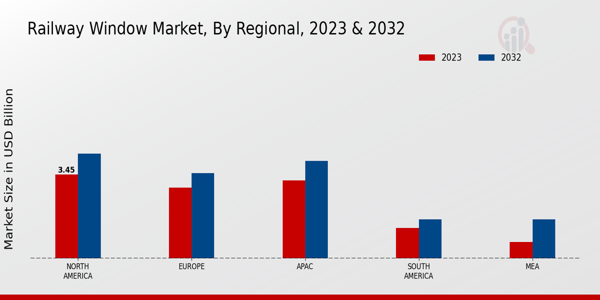Railway Window Market Overview
As per MRFR analysis, the Railway Window Market Size was estimated at 12.19 (USD Billion) in 2024. The Railway Window Market Industry is expected to grow from 12.56 (USD Billion) in 2025 to 16.40 (USD Billion) till 2034, at a CAGR (growth rate) is expected to be around 3.12% during the forecast period (2025 - 2034).
Key Railway Window Market Trends Highlighted
The railway window market is experiencing several key market drivers that influence its growth. One significant driver is the increasing emphasis on passenger comfort and safety, leading to innovations in window designs and materials.
Additionally, the rise in urbanization and government investments in railway infrastructure are contributing to a higher demand for modern railway systems. Enhancements in window technology, such as energy-efficient glazing and stronger yet lighter materials, are also becoming essential as rail systems seek to improve their overall efficiency and attractiveness to passengers.
Opportunities to be explored in this market include the growing trend towards sustainable transportation solutions. Railways are seen as an eco-friendly mode of transport, prompting manufacturers to focus on developing windows with a reduced environmental impact.
The integration of smart technologies in railway windows, such as self-tinting or noise-cancellation features, presents another avenue for growth. Furthermore, expanding railway networks in emerging economies can open new markets for window suppliers, allowing for innovation in design tailored to specific regional needs.
Trends in recent times indicate a shift towards increased customization of railway windows to meet diverse aesthetic and functional requirements. As rail operators look to enhance their brand image, the design of windows plays a crucial role in shaping the passenger experience.
Additionally, long-term maintenance considerations are becoming an important factor in window design, leading manufacturers to explore materials that require less upkeep. These evolving dynamics are redefining how railway windows are perceived and integrated into modern rail systems, setting the stage for a dynamic market environment.

Source Primary Research, Secondary Research, MRFR Database and Analyst Review
Railway Window Market Drivers
Increasing Investment in Railway Infrastructure
One of the most significant drivers for the railway window market is the increasing investment being made globally in railway infrastructure.
Many countries are recognizing the importance of efficient public transportation systems, leading to substantial funding for the development and upgrade of railway networks. This investment is not only aimed at enhancing passenger convenience but also at boosting freight transport capabilities, which is essential for economic growth.
New projects are being launched, including high-speed trains, urban transit systems, and regional rail networks, all of which require high-quality railway components, including windows. Additionally, as governments strive to reduce traffic congestion and lower carbon emissions, they are prioritizing public transport, further driving the demand for advanced railway infrastructure.
With 2024 marking the beginning of significant budget allocations for many national and regional transport schemes, the railway window market is poised for growth, fueled by the need for innovative and durable window solutions that meet modern regulatory and safety standards.
Manufacturers are focusing on research and development to create windows that are not only aesthetically pleasing but also energy-efficient and capable of withstanding varying climatic conditions. Moreover, the rise of smart and automated trains is driving innovations in window designs to enhance passenger comfort and safety, marking a new era in the railway industry.
As such, the increasing investment in railway infrastructure stands out as a crucial driver in sculpting the future landscape of the railway window market.
Growing Urbanization and Passenger Demand
Urbanization is accelerating worldwide, leading to an increased demand for efficient public transport systems, including railways. As cities expand and populations grow, the need for reliable commuter services is driving investments in rail infrastructure.
This trend directly impacts the railway window market, as new train systems and upgraded rolling stock require modern, durable, and efficient window solutions. High commuter demand necessitates the development of trains designed for greater capacity and improved service frequency, thereby increasing the need for innovative window technologies that enhance passenger experience and safety.
Technological Advancements in Railway Design
Technological advancements in railway design are another pivotal driver for the railway window market. Innovations in materials and manufacturing processes have led to the development of lightweight, high-strength window solutions that improve energy efficiency and safety.
These advancements enable trains to operate at higher speeds and with better aerodynamics, fostering growth in the railway sector. The market also witnesses a trend towards smart windows, equipped with features like dynamic tinting and energy-saving technologies, which cater to the evolving preferences of modern passengers seeking comfort and sustainability.
Railway Window Market Segment Insights
Railway Window Market Material Type Insights
The railway window market, segmented by material type, represents a crucial aspect of the overall industry, projected to achieve a significant valuation in the coming years.
Among these materials, glass held the largest share, valued at 3.5 billion USD in 2023, and is estimated to reach 4.5 billion USD by 2032, indicating its dominance in the market owing to its clarity, durability, and superior insulation properties.
Following glass is polycarbonate, valued at 2.8 billion USD in 2023 and anticipated to grow to 3.6 billion USD by 2032. This material's lightweight nature and high impact resistance made it highly relevant in modern railway applications, particularly in designs focused on safety and efficiency.
Acrylic, although slightly less dominant, held a significant portion of the market, valued at 2.7 billion USD in 2023 and expected to increase to 3.4 billion USD by 2032. Its comparative affordability and varying aesthetic options render it an attractive alternative for several railway windows.
Lastly, aluminum, valued at 2.48 billion USD in 2023, with a projected increase to 3.5 billion USD by 2032, offers strength and lightweight benefits, making it particularly useful in the construction of frames and structures supporting glass and polycarbonate installations.
The interplay of these materials presents diverse advantages that drive the railway window market growth. Innovations and advancements in manufacturing processes are likely to enhance the performance of these materials, compelling manufacturers to focus on integrating modern technology with traditional railway designs.
The market is further bolstered by the rising emphasis on safety standards and environmental considerations, driving preferences toward materials with better thermal and acoustic performance.
Overall, the railway window market segmentation by material type underscores an evolving landscape where materials like glass, polycarbonate, acrylic, and aluminum not only significantly contribute to market value but also reflect the shifting demands of modern railway infrastructure.

Source Primary Research, Secondary Research, MRFR Database and Analyst Review
Railway Window Market Window Type Insights
The railway window market showcases a diverse segmentation within the window type category, significantly impacting the industry. This market includes various types, such as fixed windows, sliding windows, hatch windows, and emergency exits, each playing a crucial role in railway design and functionality.
Fixed windows are essential for providing structural integrity and aesthetic value, while sliding windows offer convenience and flexibility for passengers. Hatch windows are increasingly relevant for maintenance access and ventilation, enhancing overall safety.
Emergency exits are particularly significant, ensuring rapid evacuation in critical situations, thus dominating the safety segment of the market. The growth of the rail sector globally, coupled with advancements in window technology, supports market expansion and reflects the increasing demand for efficient rail systems.
As rail operators focus on enhancing passenger experience and safety, key trends in the railway window market include the integration of lightweight materials and improved design features. These dynamics, alongside challenges such as regulatory compliance and environmental sustainability, shape the competitive landscape and create substantial opportunities for innovation within the industry.
Railway Window Market Application Insights
The railway window market revenue is on an upward trajectory, primarily driven by diverse applications across various train types.
Passenger trains, being a significant part of this market, demand high-quality windows for improved aesthetics and safety, catering to comfort-driven travelers. Freight trains also hold considerable market share as robust window designs are essential for durability and functionality in transporting goods.
High-speed trains represent a transformative segment, emphasizing advanced aerodynamic window designs that enhance speed and reduce drag. Meanwhile, suburban trains play a vital role in daily commuting, where high visibility and energy efficiency are prioritized, making them an essential focus for market growth initiatives.
As such, the railway window market segmentation reveals crucial insights into industry dynamics, showcasing trends towards innovation and sustainable practices while also highlighting challenges such as regulatory compliance and material costs that may affect overall market statistics and growth potential from 2024 to 2032.
Railway Window Market End Use Insights
The segment encompasses various applications such as public transport, private railways, and cargo transportation. Public transport consistently represents a significant portion, as urbanization and the demand for efficient travel solutions continue to rise globally, resulting in robust investment in rail infrastructure.
Private railways also have become increasingly relevant, particularly in regions where additional transport options are sought after, helping to alleviate congestion.
Meanwhile, cargo transportation is essential for the logistics and supply chain industry, emphasizing the need for durable and efficient window solutions tailored to withstand extended use under various conditions.
The diverse applications across these areas highlight the railway window market's extensive reach, driven by evolving consumer needs, infrastructure advancements, and the push for sustainable transportation solutions.
Understanding the railway window market data reveals not only the dynamics of its segmentation but also the underlying trends shaping the industry, providing valuable insights for stakeholders looking to navigate this growing market landscape effectively.
Railway Window Market Regional Insights
The Regional segment of the railway window market reflects a comprehensive overview of valuations across various areas. In 2023, North America was valued at 3.45 USD billion, making it a major player in the industry, driven by advanced railway infrastructure and the demand for innovative window solutions.
Europe followed closely with a valuation of 2.91 USD billion, where the emphasis on sustainability and modernization of transport systems enhances its significance in the market. The APAC region, valued at 3.2 USD billion, shows potential for growth owing to rapid urbanization and increasing investments in railway projects.
South America, with a valuation of 1.25 USD billion, represented a developing market that is gradually gaining attention due to infrastructural improvements. Lastly, the MEA segment held a modest valuation of 0.67 USD billion.
However, it showcases opportunities for market expansion amid rising socio-economic developments. Each of these regions contributes uniquely to the overall railway window market revenue and reflects diverse growth drivers and challenges that shape the industry landscape.

Source Primary Research, Secondary Research, MRFR Database and Analyst Review
Railway Window Market Key Players and Competitive Insights
The railway window market has become a focal point of strategic interest due to the increasing demand for passenger comfort and safety in the rail transport sector. This market is characterized by various key players, each striving to innovate and enhance their offerings to gain a competitive edge.
Factors such as urbanization, the rise in passenger traffic, and advancements in rail technology have spurred growth opportunities, fostering an environment where companies are continuously pushing the boundaries of design and functionality in railway windows.
Competitive dynamics are influenced by product innovations, partnerships, and growing emphasis on regulatory standards, all of which drive the market toward new horizons of efficiency and safety. Pesa has been a significant player in the railway window market, leveraging its extensive expertise in railway vehicle manufacturing to establish a strong market presence.
The company's strengths lie in its commitment to high-quality standards and innovative designs that enhance passenger experience. Pesa's focus on producing windows that are not only aesthetically pleasing but also durable and energy-efficient has positioned it favorably against competitors.
The company emphasizes sustainability in its product offerings, ensuring that its solutions meet stringent environmental regulations while also catering to the evolving demands of modern rail systems. Furthermore, Pesa's robust research and development initiatives allow it to stay ahead in adapting to technological advancements and user preferences, giving it an edge in this competitive landscape.
CRRC has carved a niche for itself within the railway window market by adopting a forward-thinking approach characterized by innovation and scalability. The company is one of the largest manufacturers of passenger trains and is recognized for integrating cutting-edge technologies into its railway windows.
CRRC's attention to safety standards and compliance with international regulations further solidifies its reputation. Its ability to customize window solutions tailored to the needs of various rail applications enhances its appeal to a diverse clientele.
The strategic partnerships CRRC has established enable the company to expand its market reach, ensuring its offerings not only fulfill current demands but also anticipate future trends in passenger rail transport. Through continuous investment in technology and design, CRRC is well-positioned to maintain its relevance and competitiveness in the railway window market.
Key Companies in the railway window market Include
- Pesa
- CRRC
- KnorrBremse
- Boeing
- Stadler Rail
- Hitachi
- Siemens
- Alstom
- Wabtec Corporation
- Genova
- Bombardier
- Mitsubishi Heavy Industries
- Toshiba
Railway Window Market Developments
The railway window market has seen significant developments recently, with players like CRRC and Siemens leading innovations in energy-efficient and durable window solutions suitable for modern trains. There is a heightened focus on sustainability and advanced materials, driving investment in technologies that enhance user experience and safety.
In terms of mergers and acquisitions, Alstom has solidified its market position with its acquisition of Bombardier’s rail division, signaling a strategic move to expand its product offerings and market reach. Moreover, Wabtec Corporation continues to enhance its portfolio through strategic partnerships aimed at innovative window designs that cater to new rail standards.
Companies such as Stadler Rail and Hitachi have also been pivotal in adopting smart technology aimed at improving the functionality of railway windows in alignment with urban transit systems. Additionally, the growing demand for high-speed rail services has highlighted the need for advanced window solutions, thus boosting the valuation of companies within the sector.
This trend indicates a robust outlook for market growth, driven by technological advancements and strategic mergers that enhance competitive positioning in the industry.
Railway Window Market Segmentation Insights
- Railway Window Market Material Type Outlook
- Glass
- Polycarbonate
- Acrylic
- Aluminum
- Railway Window Market Window Type Outlook
- Fixed Windows
- Sliding Windows
- Hatch Windows
- Emergency Exits
- Railway Window Market Application Outlook
- Passenger Trains
- Freight Trains
- High-Speed Trains
- Suburban Trains
- Railway Window Market End Use Outlook
- Public Transport
- Private Railways
- Cargo Transportation
- Railway Window Market Regional Outlook
- North America
- Europe
- South America
- Asia Pacific
- Middle East and Africa
Railway Window Market Report Scope
| Report Attribute/Metric |
Details |
|
Market Size 2024
|
12.19 (USD Billion)
|
|
Market Size 2025
|
12.56 (USD Billion)
|
|
Market Size 2034
|
16.40 (USD Billion)
|
|
Compound Annual Growth Rate (CAGR)
|
3.12% (2025 - 2034)
|
|
Report Coverage
|
Revenue Forecast, Competitive Landscape, Growth Factors, and Trends
|
|
Base Year
|
2024
|
|
Market Forecast Period
|
2025 - 2034
|
|
Historical Data
|
2019 - 2023
|
| Market Forecast Units |
USD billion |
| Key Companies Profiled |
Pesa, CRRC, KnorrBremse, Boeing, Stadler Rail, Hitachi, Siemens, Alstom, Wabtec Corporation, Genova, Bombardier, Mitsubishi Heavy Industries, Toshiba |
| Segments Covered |
Material Type, Window Type, Application, End Use, Regional |
| Key Market Opportunities |
Increasing urbanization demands, Eco-friendly window solutions, Smart window technology integration, Replacement of aging infrastructure, Expansion of high-speed rail projects |
| Key Market Dynamics |
Rising railway infrastructure investments, Increasing passenger comfort demand, Eco-friendly material adoption, Technological advancements in design, Growing urbanization and connectivity |
| Countries Covered |
North America, Europe, APAC, South America, MEA |
Frequently Asked Questions (FAQ) :
The railway window market is expected to be valued at 16.40 USD billion by the year 2034.
The expected CAGR for the railway window market is 3.12% from 2025 to 2034.
North America is anticipated to have the largest market share, valued at 4.3 USD billion in 2032.
The Glass segment of the railway window market is expected to be valued at 4.5 USD billion in 2032.
Key players in the railway window market include Pesa, CRRC, KnorrBremse, Boeing, and Stadler Rail.
The Polycarbonate segment of the railway window market is projected to be valued at 3.6 USD billion in 2032.
The expected market size for the South American region is 1.6 USD billion in 2032.
The projected market value for the Aluminum segment is 3.5 USD billion in 2032.
The APAC region is expected to experience significant growth, reaching a market value of 4.0 USD billion by 2032.
The Acrylic segment of the railway window market is anticipated to be valued at 3.4 USD billion in 2032.

















